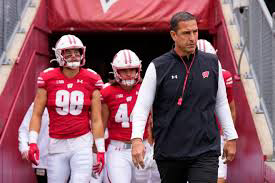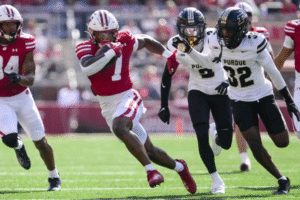
A Deep Backfield: Wisconsin Badgers Navigating Running Back Abundance
The Wisconsin Badgers find themselves in a compelling scenario this season, boasting an unusually large and talented group of running backs. This unique situation presents both a challenge and an opportunity—how to manage such an array of capable players when there are only so many snaps, carries, and minutes to go around. It’s the kind of “problem” most programs would love to have, but one that requires careful balancing to keep the unit effective and engaged.

Returning to Madison this year are six promising backs, including sophomores Darrion Dupree, Dilin Jones, and Gideon Ituka. They’re joined by other notable contributors such as Cade Yacamelli, Mason Lane, and brothers Harrison and Grover Bortolotti. The depth is so significant that the coaching staff has shifted former running back Jackson Acker into a different position, utilizing him more as a hybrid fullback and tight end to make the most of his athleticism without further congesting the running back room.
However, as with any position group, only a handful of players can realistically expect consistent playing time. For the 2025 season, Darrion Dupree has emerged as the likely lead back in the rotation. He’s projected to handle the bulk of the workload, largely due to his performance, skillset, and ability to shoulder responsibility. Cade Yacamelli is expected to reprise a flexible role similar to what he held in the previous season, contributing across multiple packages but likely with a reduced number of touches. Meanwhile, Gideon Ituka is anticipated to step in as the power back option—coming in during short-yardage or goal-line situations where his physicality and strength can be used most effectively.
Dilin Jones: The Versatile Asset with Untapped Potential
Amid this stacked backfield, the player generating the most intrigue is Dilin Jones, a highly touted four-star recruit who joined the program with considerable expectations. Despite a quiet freshman year with limited snaps, coaches and fans alike remain excited about his long-term potential. His physical attributes—size, speed, vision, and balance—make him one of the most well-rounded backs on the roster. But unlocking that potential requires carving out the right role for him within a crowded group of talented teammates.
Jones is not your prototypical back. He combines traits that aren’t always seen in one package: he’s tall and solidly built, yet he maintains a quick burst and excellent top-end speed. One of his most valuable assets is his running style—low to the ground with strong leg drive—which makes him a challenge to bring down. While he’s not a back who always looks to initiate contact, he has the physical tools to shed tacklers or run through them if needed.
What makes Jones stand out most is the way he could be used to inject life into the offense. Unlike Dupree, who fits more into the mold of a classic workhorse back—smaller but stocky, capable of handling 20+ carries a game with a grinding run style—Jones offers an element of change. He has the traits needed to act as a sparkplug, someone who can shift the tempo or catch defenses off guard with his versatility.
A Tailored Role: Change-of-Pace Back
In modern football, where offensive versatility is key, having backs who complement each other rather than compete for the exact same role is a necessity. This is where Jones becomes vital. The term “change-of-pace” is often thrown around in football discussions, but for Jones, it’s more than a label—it could define his breakout path.
Jones has the makings of a player who can enter a game when defenses are tiring or becoming too adjusted to the primary attack. He has enough agility to make defenders miss in space and the raw speed to turn small creases into big gains. Additionally, his frame makes him suitable for taking hits and bouncing off defenders in traffic. His combination of traits allows him to serve as the “curveball” in the Badgers’ offensive playbook—different enough from Dupree and Ituka to cause opposing coordinators to think twice.
Head coach Luke Fickell and offensive coordinator Jeff Grimes are tasked with orchestrating a dynamic offense that can adapt in real time. Grimes in particular has a reputation for finding creative ways to use multiple running backs throughout a season. Last year, during his time working with Kansas, he employed a two-back system to great success. Devin Neal was the primary ball-carrier, averaging 18 carries per game. But his backup, Daniel Hishaw Jr., contributed meaningfully with about 10 carries a game of his own, often changing the rhythm of the offense. Hishaw only played in eight games, but when available, he was crucial in keeping the offense unpredictable.
This kind of rotation could be exactly what Wisconsin needs to maximize the talent in its backfield, and it’s not hard to imagine Jones filling a Hishaw-like role—one where he receives consistent touches in every game, but not necessarily the bulk of them. The goal wouldn’t be to match Dupree’s production, but rather to create impact moments with fewer opportunities.
The Balancing Act: Depth vs Opportunity
Of course, the major challenge in deploying such a deep backfield is keeping everyone engaged, focused, and prepared. There’s always the risk that underutilized players become frustrated, especially in an era where the transfer portal is always looming as an option for young athletes. The coaching staff needs to manage not just game plans, but personalities and expectations as well.
Fortunately, Grimes’ track record suggests that he’s well-suited for the task. He has consistently shown an ability to design offensive schemes that play to the strengths of his roster. Whether it’s utilizing two-back sets, implementing passing plays to get backs into space, or deploying motion to confuse defenses, his offenses typically spread the ball effectively. If the same philosophy is applied in Madison, there’s a strong chance that each back—Jones included—finds meaningful ways to contribute.
Another factor working in Jones’ favor is his versatility. In today’s game, running backs are expected to be more than just runners. They must block, catch, and occasionally serve as decoys. Jones is more than capable in all these facets, which gives the Badgers even more flexibility in how they use him. He doesn’t need to line up solely in the backfield; he could be motioned out wide or used in screen game scenarios. The more dimensions he can add, the harder it becomes for defenses to predict how Wisconsin intends to use him.
Eyes on the Future, But Feet in the Present
It’s worth noting that this is still a young running back group. Most of the names mentioned—Dupree, Jones, Ituka, and Lane—are either sophomores or redshirt freshmen. This means the decisions being made today will have implications for future seasons. Finding a way to establish a rhythm this year could set the foundation for an even more explosive offense in 2026 and beyond.
While Dupree may take center stage for now, the coaching staff is undoubtedly aware that injuries, game flow, and opponent schemes will all play a role in determining who gets the ball. As the season progresses, it wouldn’t be surprising to see Jones’ workload increase, especially if he capitalizes on early opportunities. It’s easy to imagine a scenario where Jones becomes the “hot hand” in a midseason game and forces the staff to give him more responsibility.
That said, the staff doesn’t appear rushed. Developing Jones into the best version of himself requires patience and the right context. If they try to fit him into a role that doesn’t align with his strengths, they risk stunting his development. But if they gradually introduce him into more specific packages—short bursts, two-minute drills, or misdirection plays—they can help him build confidence while learning the nuances of college football.
Final Thoughts: Making the Most of a Loaded Room
In summary, the Wisconsin Badgers are in a fortunate position: they have more capable running backs than they can reasonably use in a traditional one-back system. But rather than seeing this as a problem, the team appears ready to embrace it as a competitive advantage.
Darrion Dupree looks primed to become the go-to option. He’s earned the right to carry the majority of the workload based on his consistency and physical build. Behind him, Cade Yacamelli brings a jack-of-all-trades approach that adds versatility, while Gideon Ituka offers raw strength and goal-line utility.
Then there’s Dilin Jones—the back who might not have a permanent place carved out yet, but who certainly has the tools to make an immediate difference. His running style, physicality, and adaptability make him a perfect candidate to fill a change-of-pace role that gives the Badgers an edge. If utilized correctly, he could be a secret weapon that alters games in key moments.
Whether it’s through a dual-back system, creative formations, or situational sub-packages, Jones has the opportunity to carve out a meaningful niche on this team. And in doing so, he may help transform Wisconsin’s offense into one of the more multi-dimensional units in the Big Ten.
Leave a Reply